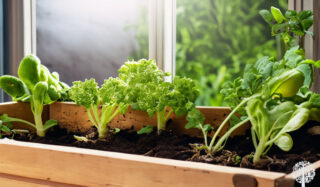How To Make A Window Box Garden
Growing an all-natural indoor window box garden can be a great way to keep a gardener busy in the off-season. Many variations exist, but if handled correctly, the concept is simple and effective. You can create a mini-garden right in your window with lettuce, kale, radishes and more.
The Right Size And Placement
Getting started on a box garden can be simple if you find one premade that fits the window’s width. Otherwise, you’ll have to make a box from scratch. Make a wooden box that has almost no spacing between the boards. It should be as wide as the window you will place in it. The box can sit on the ground if your window is low enough. Otherwise, place the container on something to ensure it gets the most light possible.
Use a natural liner like burlap if the boards on the box have significant gaps to let soil slip through. Source a natural organic soil that is well draining and has plenty of nutrients readily available. A mix of humus, coir, peat and perlite has been the go-to for years.
After deciding what soil mix to use, fill the box almost to the top, leaving just enough room to protect the edges from spilling over. Next, place the container in the desired location with a catch tray underneath it. Washing machine trays work well for this purpose. Finally, put two boards underneath the box inside the tray to let the underside breathe; this will keep the soil from growing stagnant in case of over-watering.


Activating The Soil
It’s a great idea to water in a fulvic acid blend like Ful Power and a mycorrhizae mix like Oregonism to help activate the soil and prepare it for plant growth. Pour the mix in and let the box sit undisturbed for about ten days for the earth to activate. Letting the soil grow on its own for a while helps the beneficial fungal network and bacteria inoculate throughout the new media. After ten days, plant your seeds!
Plant Selection And Maintenance
Even indoors, it’s essential to select cold-hardy plants that don’t need a lot of light. Greens are the go-to, with plenty of other options. Tomatoes, potatoes, carrots, green beans and more have all grown in a box garden, though they will be much smaller than their outdoor counterparts.
Only water the garden when necessary. At first, the soil will need more water, but after a while, it will hold moisture for a long time. As the garden establishes, water in compost tea as required. Compost teas are the best way to offer nourishment to your plants naturally. Make a simple tea by adding a small handful of humus and earthworm castings into a 5-gallon bucket of clean water and letting it sit for a few hours before applying it to the garden. Avoid using city water; for best results, use natural spring water, reverse osmosis, or distilled water. Adding an aeration stone to the bucket allows you to brew much longer without causing anaerobic bacteria to form too quickly. The plants respond positively the next day when the tea is made correctly.
Once the garden thrives, you can regrow in the same soil indefinitely. If proper care is taken, the earth will continue to improve. Keeping up with the garden’s needs as they arise is the best preventative maintenance plan, and adding enzymes from time to time will help keep the soil clean and healthy.


Keep It Simple
Observe the reaction of your plants as they grow, and remember that, like any garden, a forest doesn’t need human attention to thrive. A little goes a long way! A window box garden is a simple solution to those wintertime blues, allowing you to learn from Mother Nature in the comfort of your own home.




